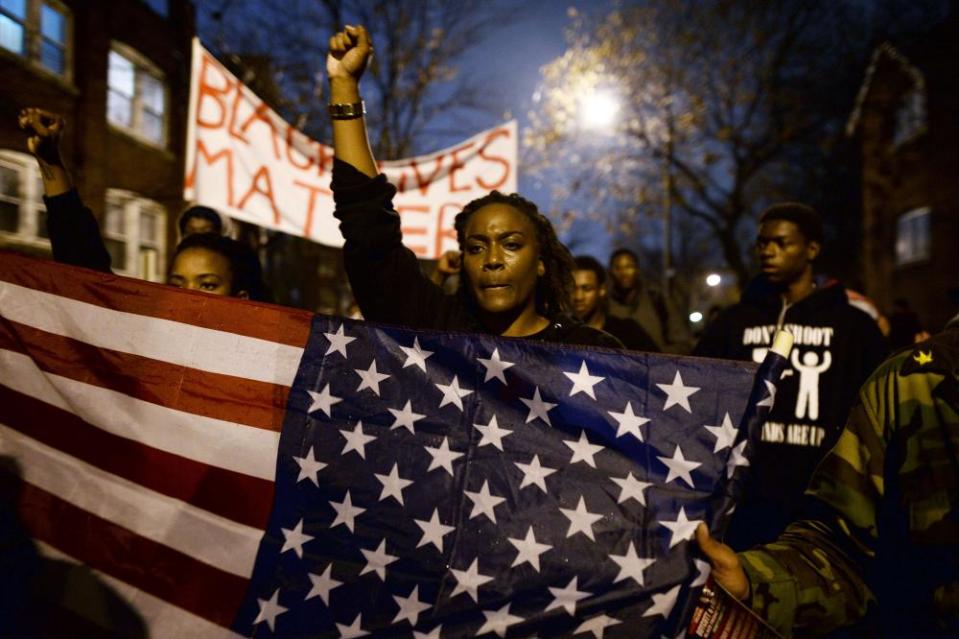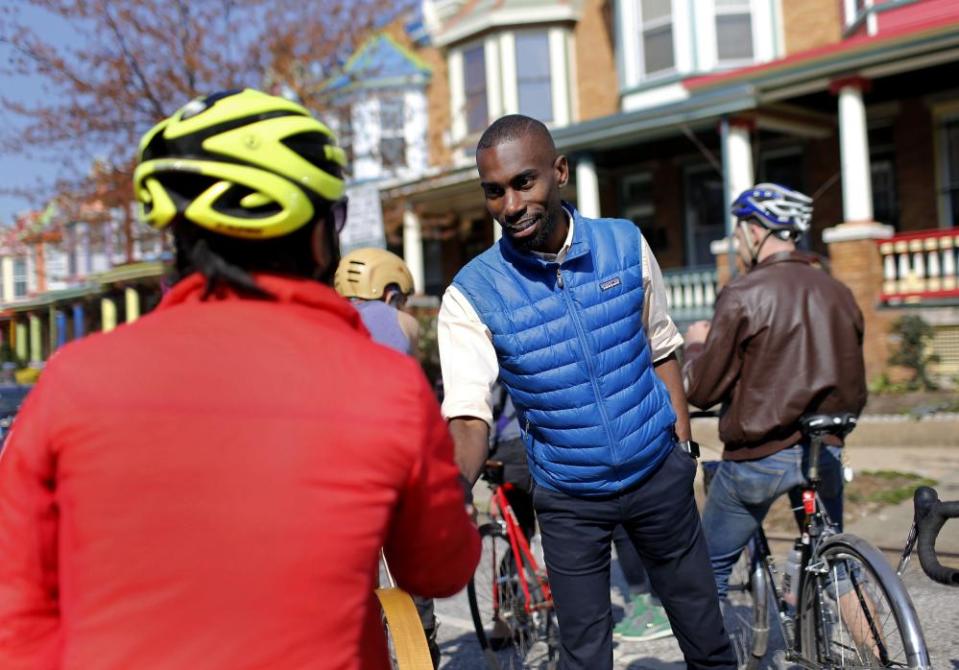DeRay Mckesson on Black Lives Matter: 'It changed the country'
The power of street protest. The disruption of technology. The fight for racial equality. The struggle against disillusionment. Few have lived the high and lows of this decade as viscerally as DeRay Mckesson of the Black Lives Matter movement.
The civil rights activist felt compelled to join spontaneous street demonstrations in Ferguson, Missouri, in August 2014, a week after Michael Brown, an 18-year-old African American man, was fatally shot by a white police officer. The protests lasted for months and were a seminal moment in the evolution of social movements – and social media.
Related: ‘I learned hope the hard way’: on the early days of Black Lives Matter
“It was really organic,” the 34-year-old from Baltimore recalled in a phone interview. “It is a myth that there was a small set of the people that started a movement. What was so beautiful about it was people came out in the street in the early days and stayed in the street. What makes the current movement so different is that it wasn’t started by an organisation, by institutions, by churches, by schools.
“In our generation, it was the first time that we saw this type of activism in the streets that was widespread and caught on. There were certainly other demonstrations across the country that happened way before the death of Mike Brown, but this one was the phenomenon.
“Technology lined up at the time. The police were so wild in a way that was so concentrated. The community was ready to engage. The media was present. All of the things happened in this one moment in a way that no person could have organised. It changed the country. It opened up a wave of activism across a host of areas and focused citizens in a way that is truly special.”

Brown’s death fed into an awakening about the national crisis of law enforcement killing people of colour. The demonstrators in Ferguson gained widespread attention. They marched all day and all night because police enforced a “five-second rule” that meant no one could stand still during a protest. Mckesson’s critiques of the policy on Twitter helped get it struck down in federal court.
“If we stood still for more than five seconds, we were arrested,” he said. “We were in the streets for 400 days. It’s a long time and the police were relentless. Most people know Mike Brown’s name, but the police killed 10 people after they killed Mike Brown so it didn’t stop.
“The protests spread across the country because the police had continued to kill people and with it you saw a generation find their public voice. People had always known these things. People talked about it and suddenly there was a broad community of not just people who identified as activists or organisers but who simply loved their community and knew that this was not the best version of it there could be.”
According to the Pew Research Center, the phrase “black lives matter” was first used by a black community organiser in a Facebook post following the July 2013 acquittal of George Zimmerman in the shooting of Trayvon Martin, a 17-year-old African American. The hashtag, and the influence of the Black Lives Matter movement, accelerated greatly in August 2014 when Brown was killed, Pew noted.
A new language for grassroots protest, social media and the mainstream media’s understanding of them was taking shape. Its heirs have included #MeToo, giving a voice to victims of sexual harassment, the Women’s March and Indivisible movement that followed Donald Trump’s election, and the March for Our Lives, a response to a 2018 mass shooting at a school in Parkland, Florida.
Mckesson continued: “With us, the media and mainstream society were learning how to talk and think about protest. And shortly, you’d see it open up space for Parkland and open up space for the Women’s March and open up space for Indivisible. By the time they came along, there was already a language, reporters knew how to talk about it, reporters understood it.
“When we were doing it, I’ll never forget the early days where the reporters were as critical of us as they were of the police, and we’re like, ‘We didn’t kill anybody!’ It wasn’t until the reporters understood it better and understood the message and the tactics that the shift happened.”
Then came the event on which the decade hinged: the 2016 presidential election. It saw America lurch from Barack Obama, its first black president, to Donald Trump, who gave succour to white supremacists. Trump lost the popular vote to Hillary Clinton but threaded the needle of the electoral college by just 77,000 votes in three battleground states where African American turnout was significantly down.
Mckesson reflected: “There was so much hope with Obama. There was so much promise, and then we saw in real time the promise fade away. You saw Trayvon get killed. You saw Mike Brown killed. You saw all these horrific things happen and it didn’t seem like there was something on the other side.
“The disillusionment hit right at that time. People would tell us to vote and we’re like, ‘I voted my entire life. I voted every election. I still got dragged out by police by my ankles. I still got arrested. I got shot at.’ Voting didn’t stop any of the bad things from happening. I think that people understood that and they inadvertently took that message to mean that voting didn’t matter.”
That was not Mckesson’s own view. He voted for the leftwing insurgent senator Bernie Sanders in the Democratic primary and Clinton in the general election. “I was shocked by activists and organisers in 2016 saying that elections didn’t matter. I was shocked by people participating in the logic that said structures didn’t matter, because there’s so much at stake in it. Those same people are now, especially given that Trump is just so wild, building voter organisations.”
There was so much hope with Obama. There was so much promise, and then we saw in real time the promise fade away
There was another factor behind the all-important dip in black voters, Mckesson added. “The other thing that happened in 2016 that the establishment left wasn’t prepared for was the long con that the right had played around voter suppression and disenfranchisement. By the time anybody realised it, it was just [too] late.”
Trump has turned back the clock, aggressively pro-law enforcement, emphasising “blue lives matter” and even appearing to advocate for rougher treatment of suspects under arrest. “Don’t be too nice,” he told law enforcement officers in Brentwood, New York, in July 2017. Mckesson believes the police have been emboldened but has numerous other concerns about the Trump administration’s legacy.
“The thing about Trump that’s so dangerous is the pace with which he’s making decisions,” he said. “Two per cent of what this administration is doing is making the news but all of it is bad. So, I think when the dust settles, when he’s out of office, only then will the public actually understand the true extent to which he has done damage. It’s all the things that are not Russia, that are not impeachment, that are not in the news.”
After Ferguson, Mckesson, instantly recognisable for his blue vest, became a leading figure in Black Lives Matter. In 2016 he ran for mayor of Baltimore, finishing sixth in the Democratic primary, and was arrested in Baton Rouge, Florida, after police shot dead 37-year-old Alton Sterling. He joined Crooked Media, a company founded by Obama alumni, and hosts its weekly podcast Pod Save the People. He has a million followers on Twitter.

Black Lives Matter goes on, decentralised and non-hierarchical with decisions in the hands of local chapters – listed on its website as Atlanta, Birmingham, Boston, Chicago, Denver, Greensboro, Lansing, Long Beach, Los Angeles, Louisville, Memphis, Minneapolis, Philadelphia, San Francisco, Washington DC and Toronto in Canada. It is running a What Matters 2020 campaign to engage communities and encourage voter registration for next year’s elections.
Mckesson, however, is on a brief hiatus. “I’ve been taking it slow at the end of the year just because I worked so hard for so long,” he says. “To have done what was done took a toll on all of us and after watching and being around people and being one of the people who struggled to just make sense of everything and all the sacrifices and all that, I really needed to just step back a little bit. So I’m excited for 2020. I have a lot of plans in 2020 with what we do around the police. I just needed to slow down for a minute.”
As a new decade dawns with Trump in the White House, inequality entrenched and police brutality stubbornly resilient, there are plenty of reasons to be ambivalent. At first, Mckesson tried to be positive: “I think in 10, hopefully less than 20 years, we’ll see a dramatic transformation. This is like the dark before the light. A lot of people fight really hard.”
But then he added: “It’s frustrating to watch people say things like, ‘I can’t believe we’re not in the streets like people in other countries.’ The reality is, when there were thousands of us risking our lives in the street, those people weren’t. So if anything, there is a whole set of people who I was in the street with who are less willing to do it again because we saw that it was gonna be a lot of lip service.
“We saw that people were going to say, ‘Oh, my God, people should be in the street,’ but would never join us. We saw that people weren’t willing to risk much and I think there’s less of a willingness to do it. It’s easy to stand in the street at 10 o’clock in the morning when there are TV crews and you’ve got a podium and it’s a concert. It’s much harder to do when the police are literally ready to kill you at 2am, it’s dark and you’re standing in a side street.”
Last year Mckesson published a book, On the Other Side of Freedom: The Case for Hope. As if mocking that title, 897 people have been shot and killed by police so far in 2019, according to a count by the Washington Post. “The police have killed more people since the protest, not less,” Mckesson said. “That is the sobering reality because it’s also a reminder that we are so much work to do. The civil rights movement was decade-long works of activism, so I’m not discouraged.
“In five years we have completely shifted the conversation about race and justice in the country. People felt like it was an impossible task and we did it without grants and workshops and all the things that people tell you you must have to be able to make to make change. So I’m incredibly proud of that.”

